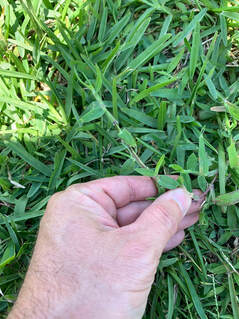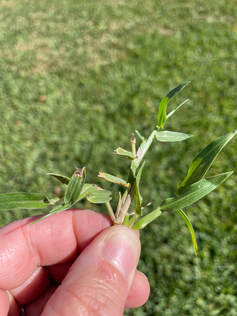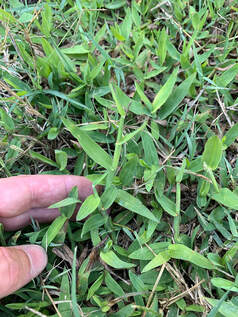One of the most troublesome group of weeds in Central Florida lawns are weeds in the grass family – generally, I refer to them as a group as “grassy weeds” from here on out. The most common grassy weeds are Crabgrass (we have five different species in Central Florida), Alexandergrass, Common Bermudagrass, Torpedograss, and Basketgrass. There are additional weeds in the grass family that infest lawns, but they are not as common or troublesome. In this article I’ll dive deeper into the individual grassy weeds to give you a better understanding of what to expect if you encounter them in your lawn, or if your service technician notifies you that any of these are becoming a problem.
Management of Grassy Weeds is difficult and often not possible using selective herbicides – more on that later as this relates to specific weeds and turfgrass species. The best management options for weeds in lawns, including grassy weeds, are to follow proper maintenance practices that contribute to a thick, healthy lawn. Additionally, periodic renovation of areas that become infested by unmanageable weeds are sometimes necessary. These practices include:
- Mow your lawn at the recommended mowing height for the species and variety.
- Mow frequently enough that no more than 1/3 of the length of the grass is removed at any one time.
- If weeds, including grassy weeds, are problematic in your lawn, remove clippings when mowing to remove the weed seed heads. Otherwise do not remove grass clippings when mowing.
- Avoid transferring weeds, including grassy weeds, from one area of your lawn to another; Or if your lawn is mowed by a landscaper, between one property to another. I know – this is easier said than done!
- Water your lawn frequently enough to prevent stress due to lack of water, and avoid watering when the lawn is water-healthy – this is probably the most frequent manageable issue that contributes to decline in lawns and in turn, predisposes the lawn to problems, including Crabgrass and other weeds, as well as fungal diseases and insect pests.
- Fertilize the lawn properly for the turfgrass species – we provide proper fertilization services.
- If soil pH issues are suspected, obtain a soil test from weaker areas of the lawn to determine if soil pH adjustments are needed – we provide this service.
- If appropriate, apply preemergent herbicides to limit germination of Crabgrass and other lawn weeds – we provide this service if and when appropriate.
- Hand-pull grassy weeds if they infest a small area of the lawn – my rule of thumb is smaller than about a Frisbee.
- For small areas of Crabgrass and Alexandergrass infestations that cannot be hand pulled – management using baking soda is possible. Sprinkle a very thin layer of baking soda over wet infested areas. The application will burn off the leaves of the weeds and allow the surrounding lawn to heal into the area. Note that following application of baking soda, you will end up with an ugly brown spot in your lawn!
- Larger areas of grassy weeds infestations in lawns should be killed using a nonselective herbicide such as Glyphosate. Following death of the weeds, remove the dead area down to bare soil. At this point we recommend to wait a few weeks for weed seeds to germinate, at which point you should apply nonselective herbicide again to kill the new weeds. Now you are ready to plant new sod into the bare area.
Crabgrass
Crabgrass (Digitaria sp.) is one of the most problematic weeds in residential and commercial landscapes. A number of years ago there was a selective herbicide available to professionals for legally-treating Crabgrass in residential St. Augustinegrass. While still available for purchase, this product cannot be legally-applied to lawns in residential or commercial properties, per the product labeling, which is federal law. Professionals and homeowners alike have been at a loss for a selective Crabgrass control method, particularly in residental St. Augustinegrass lawns. In Zoysiagrass and Bermudagrass there are several products labeled for management of some of the Crabgrass species.
Blanket Crabgrass is probably the most common species of Crabgrass infesting lawns in Central Florida. It can be differentiated from other species of creeping Crabgrass species by the presence of hairs on the leaves and stems. This species is technically a summer annual, meaning it germinates in the summer and dies in late fall and into winter. However this weed hasn’t read the textbook recently, and has become a short-lived perennial. Where we expected to see this weed die off during winter just a few years ago, these days we are definitely seeing it flourish in lawns through the winter. In St. Augustinegrass, our industry does not have a selective herbicide that we can use to treat this weed – in other words, there is no product that is effective to treat this weed without killing your St. Augustinegrass. In Zoysiagrass we can treat for this weed. Since this species of Crabgrass tends to linger in lawns and not die out annually, preemergent herbicides are not particularly useful for managing it.
For management recommendations for Blanket Crabgrass, follow the instructions under Management of Grass Weeds at the head of this article.
India Crabgrass is very similar to Blanket Crabgrass. They differ in that India Crabgrass lacks hairs on the leaves and stems. Like its counterpart, India Crabgrass hasn’t read the textbook either, and tends to be a perennial in Central Florida. From a management perspective, this weed is very similar to Blanket Crabgrass.
For management recommendations for India Crabgrass, follow the instructions under Management of Grass Weeds at the head of this article.
Southern Crabgrass, Large Crabgrass, and Tropical Crabgrass are difficult to differentiate. Differences correspond to the location of seed head emergence from the grass stem. All three of these Crabgrass species are summer annuals – this means that they germinate throughout spring through summer and die in late fall to winter. While these species of Crabgrass can be troublesome in lawns, they are not as prevalent as Blanket Crabgrass and India Crabgrass. Preemerget herbicides can be quite useful to prevent these Crabgrass species from infesting lawns. Unfortunately there are no effective selective herbicides available for management of these Crabgrass species in St. Augustinegrass lawns. These weeds are manageable in Zoysiagrass.
For management recommendations for Southern Crabgrass, Large Crabgrass, and Tropical Crabgrass, follow the instructions under Management of Grass Weeds at the head of this article.



